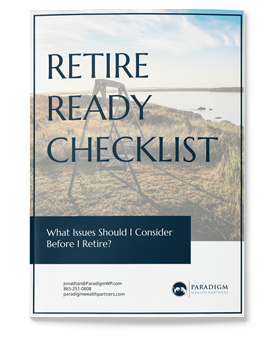Preparing for Healthcare Costs in Retirement: Tips for Peace of Mind
When it comes to retirement planning, there is a lot of ball-parking expenses. But perhaps the biggest wild card is healthcare costs. They seem to grow exponentially year after year with no slowdown in sight.
The cost of healthcare grows faster than the cost of other goods and services. Over the last 20 years, the Consumer Price Index (the average change in prices paid by urban consumers for various goods and services) has grown on average 2.5% per year, while the CPI for healthcare has grown on average 3.2% per year.
According to Fidelity Investments’ 2022 Retiree Healthcare Cost Estimate, the average American couple estimates the total cost of healthcare during retirement at $41,000. But in reality, the number is much, much higher. The average 65-year-old couple retiring this year can expect to spend an average of $315,000 on healthcare expenses throughout their retirement.
But knowledge is power. Knowing that healthcare costs may consume a more significant chunk of our retirement savings than we anticipated can help us prepare. These tips will help give you peace of mind when planning for retirement.
Health Insurance and Early Retirement
The traditional retirement age is 65, and Medicare eligibility kicks in at 65. But what about those who want to retire before turning 65? Going without insurance is out of the question. Even a relatively minor illness or accident could cost thousands of dollars which you would be 100% responsible for.
There are a few options for obtaining health insurance between early retirement and Medicare eligibility.
State Health Insurance Marketplace
Under the Affordable Care Act, each state has a health insurance marketplace where you can buy private individual or family health insurance. You are eligible regardless of medical history, and any pre-existing conditions will be covered as soon as the plan goes into effect. Enrollment is limited to an annual open enrollment period or a special enrollment period triggered by a qualifying event. Losing employer-sponsored health insurance due to early retirement is a qualifying event.
COBRA
Consolidated Omnibus Budget Reconciliation Act (COBRA) coverage or state continuation coverage may be an option depending on several factors, including:
- How long until you’re Medicare eligible
- How much you’ve spent on out-of-pocket costs for the year
- Whether you’re eligible for marketplace subsidies
- Whether you’re able to keep your existing medical providers if you switch plans
Some employers offer to subsidize COBRA coverage, but if yours doesn’t, you’ll have to pay the full price, which can be expensive.
Spouse’s Health Insurance
If your spouse plans to continue working and has access to health insurance that offers spousal coverage, you can enroll in that plan once your own coverage is terminated. Your loss of coverage through retirement is considered a special enrollment period.
If you and your spouse were covered under your plan, you can both transition to your spouse’s plan if coverage is available when your existing plan is terminated.
Medicare Premiums and IRMAA
Medicare Part B covers several “medically-necessary” services, including:
- Doctor’s services and tests
- Outpatient care
- Home health services
- Durable medical equipment
- Some preventative services
For 2023, Medicare Part B premiums are $164.90 per month. But some people will be hit with a surcharge known as an Income-Related Monthly Adjustment Amount (IRMAA), Medicare’s extra charge for high-income beneficiaries. For 2023, it can more than triple Part B premiums to as much as $560.50 a month.
IRMAA surcharges are determined by the beneficiary’s modified adjusted gross income (MAGI). For 2023, IRMAA applies for those with a MAGI over $97,000 or $194,000 for married couples filing jointly.
The amount of the surcharge is based on a sliding scale and increases with each of five IRMAA-related income brackets. The thresholds change each year, partly based on inflation.
There is also an IRMAA surcharge for high-earning beneficiaries who have Part D plans (prescription drug coverage) which can add an additional $76.40 per month on top of the regular premium of $31.50.
If you get a notice that you owe an IRMAA surcharge, you may be able to reduce or eliminate it by showing that your MAGI was incorrect or proving that you had one of the following “life-changing” events that reduced your income:
- Marriage
- Divorce
- Death of a spouse
- Work stoppage
- Work reduction
- Involuntary loss income income-producing property
- Loss of pension income
- Loss of employer settlement payments due to its closure or bankruptcy
Generally, you must appeal within 60 days of receiving an IRMAA notice.
Covering Costs Not Covered by Medicare
These are some expenses not typically covered by Medicare:
- Opticians and eye exams
- Hearing aids
- Dental work
- Overseas medical care
- Podiatry
- Elective cosmetic surgery
- Nursing home care
There are several options to pay for expenses that Medicare doesn’t cover.
Medicare Supplement Plans
Medicare Supplement Insurance (Medigap) is additional insurance you can buy from a private health insurance company to help cover your share of the out-of-pocket costs from your Medicare coverage, including copays, coinsurance, and deductibles.
In order to buy a Medigap policy, you must have both Medicare Part A (hospital insurance) and B (medical insurance). All Medigap policies are standardized; they offer the same basic benefits regardless of the state you live in or the company you buy the policy from.
There are ten different types of Medigap plans offered in most states, and they’re named by letter; A-D, F, G, and K-N.
Medicare Advantage Plan
Medicare Advantage Plans, also called Medicare Part C, are offered by Medicare-approved private health insurance companies and are an alternative to Original Medicare (Medicare Parts A and B).
Medicare Advantage Plans may have no premium or lower premiums than Medigap and prescription drug insurance plans. These plans cover hospitals, doctors, often prescription drugs, and some services not covered by Medicare, including hearing, dental, and vision care.
If you choose to join a Medicare Advantage Plan, you will still have Medicare, but most of your Part A and B coverage will come from your Advantage Plan and not Original Medicare. If you have Medicare Advantage, you cannot buy a Medigap plan.
Medicare Advantage Plans are similar to traditional health insurance like that offered by employers. There is a network of providers, and you must stay in network for the care to be covered. You’ll pay deductibles, copays, and coinsurance.
For those without significant medical needs, Medicare Advantage may be a cheaper option than Original Medicare. But if you do need a lot of medical care, the out-of-pocket costs can add up quickly, although there is a cap. For 2023, the cap is $8,300.
Save in an HSA
Health Savings Accounts (HSAs) are accounts for those with high-deductible health plans (HDHPs). The money is not taxed when contributed or when withdrawn as long as it’s used for qualified medical expenses.
If you enroll in Medicare Part A and or B, you can no longer contribute pre-tax dollars to your HSA, but you can make withdrawals to pay for qualified medical expenses, including deductibles, premiums, copays, and coinsurance.
Long Term Care Insurance vs. Self-Insuring
Medicare doesn’t cover nursing home care, and the cost of it is eyewatering. Genworth has a great tool to show just how expensive long-term care is. These are some estimated yearly costs for 2023 in Knoxville, Tennessee:
- Homemaker services: $60,563
- Home health aid: $60,028
- Adult day health care: $19,308
- Assisted living facility: $48,663
- Nursing home semi-private room: $90,999
- Nursing home private room: $96,807
Medicare does not pay these expenses. It’s easy to see just how quickly the cost of long-term care could drain your retirement savings. Buying long-term care insurance is one option, but the premiums are pricey, averaging $2,700 a year per person depending on a variety of factors; most importantly, the age the policy was purchased (the older you are, the more expensive the policy).
Another option is to self-insure, to set aside money to cover long-term care costs rather than buying long-term care insurance. This can be HSA money or another investment.
It’s a gamble either way, so you have to weigh your options based on your circumstances. If you have a healthy portfolio and are in good health yourself, self-insuring can be a good option. If those things aren’t true for you or your spouse, long-term care insurance may be an expense well worth paying.
If you have any questions about retirement planning or any other aspect of financial planning, reach out. We’re here to help you Life the Life You Love.



